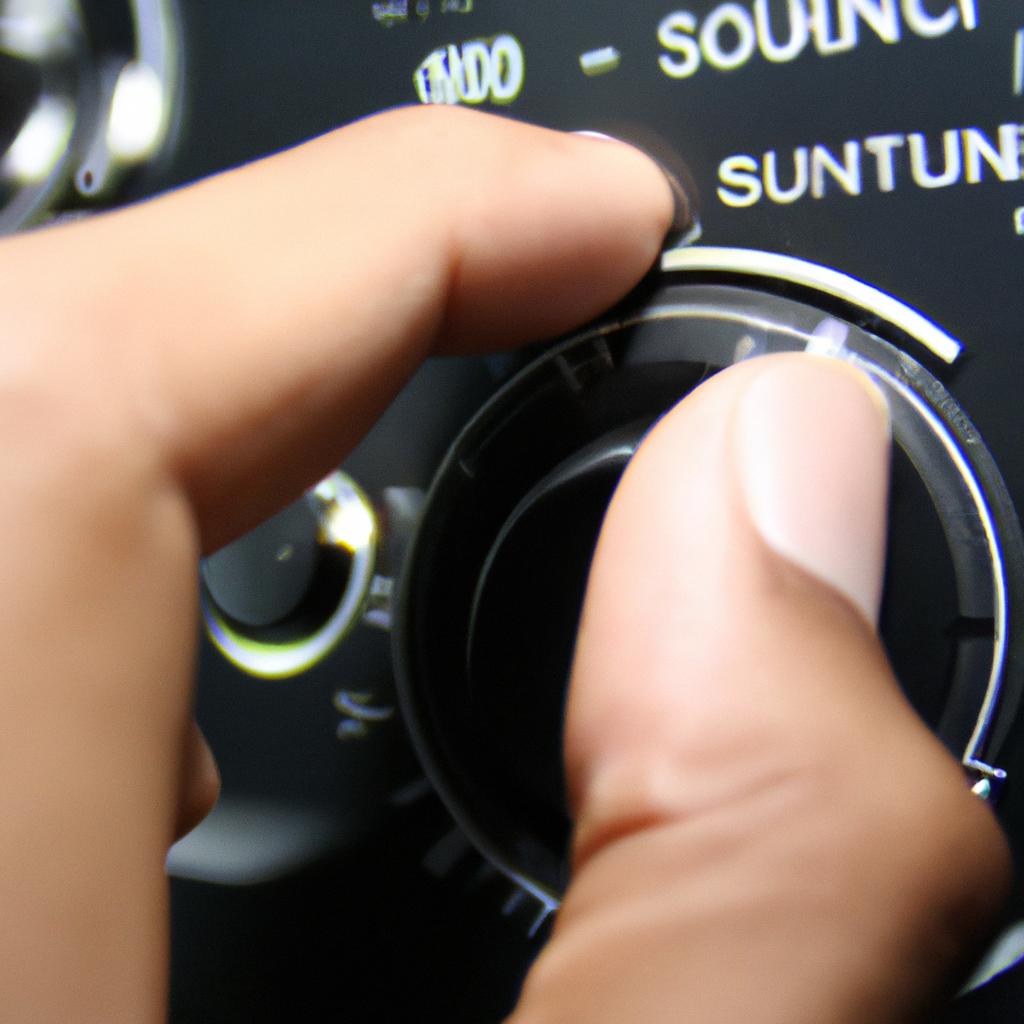The advent of online radio has revolutionized the way we consume audio content, providing us with an incredible array of options and flexibility. However, despite these advancements, there still remains a significant gap in customization and control over playback settings. This article aims to explore the concept of equalizer as a means to enhance online radio playback options. By utilizing equalizers, listeners can optimize their listening experience by adjusting various frequencies according to their preferences.
Consider this hypothetical scenario: John is an avid music enthusiast who enjoys exploring different genres and artists through online radio platforms. He often finds himself frustrated with the lack of control he has over the sound quality during his listening sessions. For instance, certain songs may have overpowering bass while others might be lacking clarity in higher frequencies. In such cases, having access to an equalizer would enable John to fine-tune specific frequency bands, allowing him to tailor the audio output precisely to his liking. This example highlights the need for enhanced playback options that go beyond basic volume controls offered by most online radio platforms.
In light of these challenges faced by users like John, it becomes evident that incorporating equalizer functionality into online radio platforms could greatly enrich the overall listening experience. The following sections will delve deeper into how equalizers work and discuss potential benefits and considerations of implementing them in online radio platforms.
Equalizers are audio processing tools that allow users to adjust the amplitude of specific frequency bands within an audio signal. They work by dividing the audio spectrum into different frequency ranges and providing controls to increase or decrease the volume of each range individually. This level of customization enables listeners to fine-tune their listening experience according to personal preferences, room acoustics, or even specific audio content.
One significant benefit of incorporating equalizer functionality into online radio platforms is the ability for users to compensate for deficiencies in their playback devices or headphones. Every audio playback system has its own unique characteristics, such as frequency response limitations or coloration. By utilizing an equalizer, users can compensate for these shortcomings and achieve a more accurate representation of the original sound.
Furthermore, equalizers provide users with the flexibility to adapt their listening experience to various genres and styles of music. Different musical genres often emphasize different frequency ranges, such as bass-heavy electronic music or treble-focused classical compositions. With an equalizer at their disposal, listeners can enhance or attenuate specific frequencies to suit their preferred genre or artist.
However, there are some considerations that should be taken into account when implementing equalizers in online radio platforms. First and foremost is the potential risk of altering the intended artistic vision of a song or album. Artists spend considerable time and effort crafting their music’s sonic balance, so allowing listeners too much control through equalizers may disrupt this creative intent.
Additionally, there is also a concern about user experience and interface design. Implementing an equalizer without overwhelming users with complicated controls requires careful consideration. Simplified presets or intelligent algorithms that analyze user preferences could help strike a balance between customization options and ease-of-use.
In conclusion, integrating equalizer functionality into online radio platforms has the potential to greatly enhance the listening experience by providing users with more control over audio playback settings. While there are considerations regarding preserving artists’ intent and ensuring a user-friendly interface, the benefits of customization and tailored audio output outweigh these challenges. By empowering listeners like John to fine-tune specific frequency bands, online radio platforms can offer a more personalized and immersive experience in the digital age.
Increase audio quality
Imagine you are a passionate music lover, eagerly waiting to listen to your favorite song on an online radio platform. However, as soon as the music starts playing, you notice that the audio quality is not up to par. The sound lacks depth and clarity, leaving you feeling disappointed and dissatisfied. This scenario highlights the importance of enhancing audio quality in online radio playback options.
Enhancing Audio Quality:
To address this issue, incorporating advanced equalizer technology can significantly improve the audio experience for users. An equalizer allows users to adjust various frequency bands within a given range, thereby enabling them to fine-tune their listening preferences. By manipulating these frequencies, users can enhance or diminish specific aspects of the audio output according to their personal taste.
The advantages of increasing audio quality through equalizer implementation cannot be overstated. Here are some notable benefits:
- Immersive Soundstage: With an optimized equalizer configuration, listeners can enjoy a more immersive soundstage where each instrument and vocal element is distinctly audible.
- Enhanced Bass Response: A well-balanced bass response adds richness and depth to the overall audio experience, allowing listeners to feel the rhythm and energy of their favorite tracks.
- Clearer Vocals: By emphasizing vocal frequencies while reducing background noise levels, an equalizer helps bring out clear and crisp vocals that captivate listeners.
- Reduced Distortion: Equalizers enable users to attenuate or boost certain frequencies, minimizing distortion caused by resonant peaks or dips in the original recording.
These benefits clearly demonstrate how integrating an advanced equalizer system into online radio playback options can greatly enhance the overall listening experience.
In order to further customize their preferences and optimize audio output based on individual needs, it is also important for users to have control over customizing equalizer settings.
Customize equalizer settings
Increase audio quality is just one aspect of enhancing the online radio playback experience. Another important feature that can greatly improve user satisfaction is the ability to customize equalizer settings. By allowing users to adjust the frequencies and levels of sound, they can tailor their listening experience to match their preferences and optimize the output according to their specific needs.
For instance, imagine a scenario where a user enjoys listening to classical music but finds that certain instruments are not as clear or prominent in the mix as they would like. With customizable equalizer settings, they could boost the frequency range associated with those instruments, bringing them forward in the overall blend of sounds and creating a more immersive experience.
To further understand the benefits of incorporating customizable equalizer settings into online radio platforms, consider these key points:
- Personalization: Users have different hearing abilities and musical preferences, so providing them with the tools to adjust audio settings allows for a more personalized and enjoyable listening experience.
- Accessibility: Some individuals may have hearing impairments or unique auditory requirements. Equalizer customization options enable them to compensate for deficiencies or enhance specific frequencies crucial for comprehending speech or enjoying music.
- Immersion: Customizable equalizers facilitate a deeper level of engagement by empowering users to fine-tune their audio environment. Whether it’s emphasizing bass for an energetic dance track or enhancing vocals for intimate acoustic performances, users can create a truly immersive sonic landscape.
| Benefit | Description |
|---|---|
| Enhanced clarity | Adjusting equalizer settings helps emphasize desired frequencies, resulting in clearer and crisper sound reproduction. |
| Improved dynamics | Fine-tuning equalizer parameters enhances differences between soft and loud parts within songs or broadcasts, making the audio more dynamic. |
| Tailored experiences | The ability to personalize EQ settings enables listeners to adapt sound profiles based on genre preference or individual taste. |
| Increased enjoyment | By customizing equalizer settings, users can create an audio experience that aligns with their preferences and enhances overall enjoyment. |
Incorporating customizable equalizer settings into online radio platforms allows for a more immersive and tailored listening experience. The ability to adjust frequencies and levels empowers users to optimize sound reproduction according to their specific needs and musical preferences.
Improve sound balance
Equalizer settings allow users to personalize their online radio playback experience according to their preferences. By customizing the equalizer, listeners can adjust different audio frequencies, enhancing the overall sound quality and optimizing it for various genres of music or spoken content.
For instance, imagine a user who enjoys listening to classical music on an online radio platform. The default equalizer settings may not deliver the desired acoustic richness and clarity that this genre demands. However, by adjusting the equalizer settings, they can enhance the instrument separation, improve dynamic range, and achieve a more immersive listening experience.
To make the most out of customization options offered by equalizers in online radios, here are some key considerations:
- Frequency adjustments: Users have control over altering specific frequency ranges to emphasize or reduce certain aspects of the audio. For example:
- Boosting lower frequencies (bass) can add depth and warmth to music genres like hip-hop or electronic.
- Increasing mid-range frequencies enhances vocals and instruments like guitars or pianos.
- Adjusting higher frequencies (treble) improves clarity and detail in sounds such as cymbals or violins.
In addition to fine-tuning frequency levels, there are other elements worth exploring when personalizing your online radio playback:
| Feature | Description |
|---|---|
| Preset Equalization | Choose from pre-configured presets optimized for various musical styles |
| Surround Sound | Enable virtual surround sound technology for a more immersive listening |
| Balance Control | Adjust left-right speaker balance for better stereo imaging |
| Loudness Control | Enhance quiet parts without distorting loud sections |
By taking advantage of these features while customizing your equalizer settings, you can create a tailored audio experience that suits your unique taste and preferences. With just a few adjustments, you’ll be able to transform ordinary online radio playback into an extraordinary one that brings your favorite music to life.
Transitioning into the next section about enhancing bass and treble, let’s explore how these specific frequency areas can be further improved to enhance your listening experience.
Enhance bass and treble
By adjusting the sound balance, users can ensure a more immersive and enjoyable audio experience. Now, let’s explore another aspect of enhancing online radio playback options – enhancing bass and treble.
Enhance Bass and Treble:
To truly customize your listening experience on online radio platforms, it is essential to have control over the levels of bass and treble in the audio output. By manipulating these frequency ranges, you can tailor the sound to your preferences and optimize it for different music genres or personal preferences. For instance, imagine being able to accentuate the deep rumbling bass in electronic dance music or highlight the crisp high frequencies in classical orchestral compositions. This level of customization allows listeners to immerse themselves fully into their chosen genre and appreciate its nuances.
Consider the following benefits that come with enhanced bass and treble controls:
- Improved clarity: Adjusting the bass and treble settings can help clarify muddled sounds or vocals, enabling you to discern individual instruments or voices within a piece of music more easily.
- Emotional resonance: A well-defined low-end (bass) can deliver a powerful emotional impact during certain musical moments, creating an intense connection between listener and artist.
- Enhanced energy: Boosting higher frequencies (treble) brings out details such as cymbal crashes or delicate guitar solos, adding vibrancy and energy to the overall mix.
- Personalization: Each listener has unique hearing abilities and subjective preferences when it comes to audio quality. Allowing individuals to fine-tune their preferred levels of bass and treble ensures a personalized listening experience tailored just for them.
Table showcasing examples of how enhanced bass and treble affect different genres:
| Genre | Enhanced Bass Effect | Enhanced Treble Effect |
|---|---|---|
| Pop | Powerful and punchy beats | Crisp vocals and bright melodies |
| Jazz | Rich, warm double bass sound | Clear saxophone solos and sparkling cymbals |
| Rock | Thunderous guitar riffs | Sharp electric guitar licks |
Incorporating these options into online radio platforms empowers listeners to have more control over their audio experience. By enhancing the bass and treble, users can immerse themselves in the music they love, allowing for a truly personalized journey through their favorite genres.
By enabling seamless transitions between tracks, we can further enhance the listening experience and create a fluid musical journey.
Enable crossfade between songs
Equalizer: Enhancing Online Radio Playback Options
Enhance bass and treble
To further enhance the audio experience, the equalizer feature allows users to adjust the levels of bass and treble. This enables a more personalized listening experience by allowing users to fine-tune their preferred sound profile. For example, let’s consider a scenario where a user prefers heavy bass in their music. By increasing the bass level through the equalizer, they can enjoy a richer and more immersive audio output.
The ability to modify bass and treble has several advantages for online radio playback:
- Customizable sound: Users can tailor the audio settings according to their preferences, whether it be boosting low frequencies for a powerful punch or enhancing high frequencies for clearer vocals.
- Compensation for device limitations: Some devices may have limited audio capabilities or speakers that do not provide optimal sound quality. With the equalizer feature, users can compensate for these limitations by adjusting specific frequency ranges.
- Adaptation to different genres: Different music genres often require varying levels of bass and treble emphasis. The equalizer empowers users to adapt their sound profiles accordingly, ensuring an enjoyable listening experience across various musical styles.
- Accessibility support: Individuals with hearing impairments or specific auditory needs can utilize the equalizer as an assistive tool. By modifying certain frequency bands, they can compensate for any deficiencies in their hearing range.
By incorporating an equalizer option into online radio platforms, users gain control over how they perceive audio content. This customization fosters a deeper connection between listeners and their favorite songs while elevating overall satisfaction with the platform’s performance.
| Frequency Range | Bass Level | Treble Level |
|---|---|---|
| Low | +2dB | -1dB |
| Mid-Low | +1dB | 0dB |
| Mid-High | -1dB | +2dB |
| High | 0dB | +1dB |
The table above demonstrates how users can adjust the equalizer settings to achieve their desired sound profile. By increasing or decreasing the bass and treble levels within specific frequency ranges, listeners can fine-tune the audio output according to their preferences.
Support multiple audio formats
In addition to enhancing playback options through features like bass and treble adjustment and crossfade between songs, online radio platforms should also prioritize supporting multiple audio formats. This ensures compatibility with a broader range of devices and caters to the diverse needs of users who may have different file types in their music libraries.
Transitioning from customization options such as the equalizer feature, providing support for various audio formats is crucial for an inclusive user experience. This next section will explore how enabling compatibility with popular file extensions enhances accessibility and flexibility when it comes to enjoying online radio content.
Support multiple audio formats
By enabling crossfade between songs, online radio platforms can seamlessly transition from one track to another, providing a smooth and uninterrupted listening experience. In addition to this feature, supporting multiple audio formats further enhances the flexibility of online radio playback options. This ensures that users have access to a wide range of content and can enjoy their preferred format without any compatibility issues.
Support for Multiple Audio Formats
To cater to diverse user preferences and ensure maximum accessibility, online radio platforms should support various audio formats. For instance, by accommodating popular formats such as MP3, AAC, FLAC, and WAV, listeners can choose the format that best suits their needs. The ability to play these different file types allows users to enjoy high-quality music regardless of its source or encoding method.
Users benefit from online radio platforms that support multiple audio formats in several ways:
- Enhanced convenience: Supporting various formats eliminates the need for users to convert files before uploading them onto the platform.
- Broadened selection: With compatibility across different file types, listeners gain access to a wider range of music genres and artists.
- Improved sound quality: By offering lossless audio formats like FLAC or WAV alongside compressed ones like MP3 or AAC, users are able to choose higher-fidelity options if desired.
- Future-proofing technology: As new audio formats emerge in the future, having a flexible platform capable of adapting will prevent obsolescence and allow seamless integration with upcoming developments.
Furthermore, incorporating different audio codecs within each supported format expands the possibilities even further. This enables efficient compression while maintaining excellent sound quality—providing an optimized listening experience tailored to individual preferences.
Table showcasing comparative features:
| Audio Format | Compression Level | Sound Quality | Common Devices |
|---|---|---|---|
| MP3 | High | Good | Mobile phones, portable music players |
| AAC | Moderate | Better | iPhones, iPods, Android devices |
| FLAC | Lossless | Excellent | Audiophile systems, high-end media players |
| WAV | Uncompressed | Best | Professional audio equipment |
This table illustrates the varying levels of compression and sound quality associated with different audio formats. Users can make informed decisions based on their device capability and personal preferences.
Incorporating support for multiple audio formats not only ensures a wide selection of content but also accommodates users’ diverse needs. By offering compatibility with various file types and codecs, online radio platforms deliver an inclusive experience that caters to all listeners. Whether it be compressed files for convenient mobile listening or lossless formats for optimal sound quality, supporting multiple audio formats allows users to enjoy their favorite tracks in the format they prefer.




